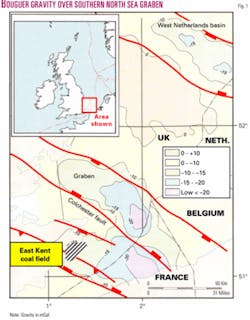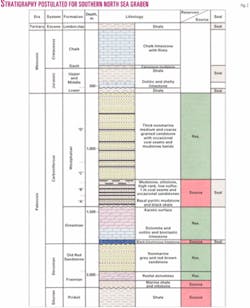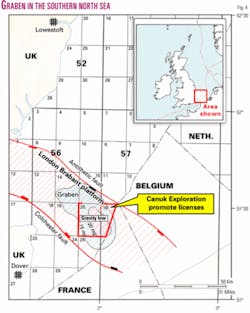New graben located on promote blocks in UK North Sea's southern gas basin
The North Sea, one of the world's major hydrocarbon provinces, is the world's seventh largest oil and gas producer. It has yielded more than 31 billion bbl of oil equivalent since the late 1960s, and an estimated 4.7 billion bbl of oil and more than 170 tcf of gas remain in the basin.
The discovery of giant Groningen gas field in the Netherlands in 1959, containing more than 100 tcf of gas in Lower Permian sandstones, was the catalyst for exploration in the North Sea. Its discovery suggested the possibility of the extension of the Permian sandstone reservoir across the North Sea into eastern England.
The absence of an international agreement prevented offshore exploration until 1964, when sufficient countries ratified the Continental Shelf Agreement, reached in 1958.
The median line in the North Sea placed the western half of the North Sea under UK jurisdiction and the eastern half to Norway, Denmark, Germany, Netherlands, Belgium, and France. The UK has the largest of these sectors.
Many companies had already acquired reconnaissance geophysical data in the southern North Sea, but drilling could not begin until petroleum legislation was enacted.
Early discoveries
The first licenses in UK offshore waters were issued in 1964, and in the following year the first UK discovery was made in the same Lower Permian Rotliegend sandstone as Groningen gas field. This was followed by the discovery of giant Leman field (12 tcf recoverable) in 1966.
Further discoveries followed quickly, and the dimensions of the southern Permian basin of the North Sea were soon established.
Early Permian subsidence established two basins separated by the Mid-North Sea high. It was discovered that the Rotliegend sands were limited to a relatively narrow east-west trending zone in the southern half. Minor gas discoveries were also found in the Triassic.
Westphalian coal measures were the source rocks and Permian Zechstein halite the overlying seal. The gas basin is limited in the north, where the main oil producing area lies, by the Mid-North Sea high and in the south by the London Brabant platform.
Prior to the drilling, the geology of the North Sea was virtually unknown, being surmised from the reconnaissance seismic and from projection of the onshore geology. It has been an intracratonic basin from the Devonian to the present.
The London Brabant platform was a well known structure, being part of a massif underlain by rigid undeformed late Proterozoic Caledonian basement, which extends from Wales to Belgium, a nonsubsiding stable block since Silurian or early Devonian time. It is an important tectonic framework and provides a potential source of detrital sediments, notably hydrocarbon source and reservoir rocks for the surrounding basins.
Attenuated Mesozoic rocks overlie a remarkably flat beveled plateau of pre-Mesozoic rocks, which was close to sea level throughout Mesozoic times with slight oscillations. Across it the Upper Cretaceous truncates Jurassic to rest on Paleozoic rocks. It was a zone of relative stability throughout Permian and Mesozoic times. Upper and Lower Carboniferous (coal measures, millstone grit, and Carboniferous limestone) thin out from the basin of northern England and the southern North Sea against the London Brabant platform and thicken to the south, in the South Wales and Kent coal fields.
During the late Carboniferous differential subsidence associated with crustal extension gave way to more uniform patterns of subsidence, possibly due to thermal subsidence. Carboniferous rocks underlie the whole of the North Sea except the Mid-North Sea high.
The Upper Carboniferous (Westphalian) is predominantly a fresh to brackish water or nonmarine clastic sequence that onlaps southwards onto the London Brabant platform, the Lower Carboniferous (Dinantian) is developed in a strongly contrasting marine facies. During the Late Cretaceous the stable massifs and highs were submerged and covered by Albian mudstones and chalk followed by a thin Lower Tertiary cover.
A new prospect
Exploration in the southern North Sea has been limited to the south by the presence of the London Brabant platform.
Geological and geophysical investigations conducted by Canuk Exploration Ltd. have revealed the presence of a graben within this platform (Fig. 1), associated with a deep gravity low, resulting from the widespread extension that occurred within the Variscan orogen and its northern foreland during Late Carboniferous and Early Permian times.
The proposed stratigraphic section in the graben, based on deep drilling onshore and the section in the nearby Kent coal field, would contain more than 2,500 m of Paleozoic and Mesozoic rocks of source, reservoir, and cap potential (Figs. 2 and 3).
An attractive aspect of the graben is the presence onshore of hydrogen sulfide in water wells and an oil seep adjacent to the main graben fault, the Colchester fault. Water in the graben is 20-50 m deep.
Canuk Exploration obtained two promote license blocks in the graben in the UK 22nd offshore round (Fig. 4). Promote licenses, a new feature of the UK government's licensing system, are attractive in having a reduced rental fee at 90% for the first 2 years, and licensees are permitted to explore a license for 2 years without committing to the drilling of a well but only to a period of further investigation such as geophysical exploration.
Several seismic lines, which would constitute the required license obligations, cross the area of interest and are available for purchase. Canuk Exploration is interested in obtaining a partner to further the exploration of its licenses in the graben.
The author
Desmond Oswald ([email protected]) formed Canuk Exploration Ltd. in 1988. The company has worked in Africa and onshore UK. He joined Chevron Canada Resources in Calgary in 1954 and has worked in Libya, Iran, Syria, and throughout the Mediterranean. He has undertaken source rock studies in East Africa, India, China, and the UK. Since 1986 he has worked as a consultant. He is a graduate of Oxford University and completed his PhD on the Carboniferous rocks of Northwest Ireland at the University of Glasgow.




